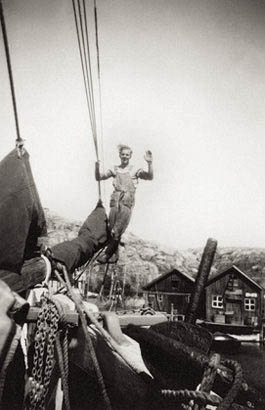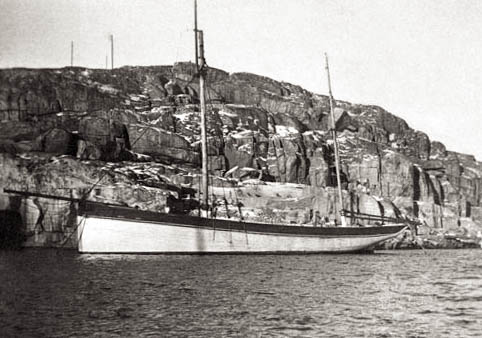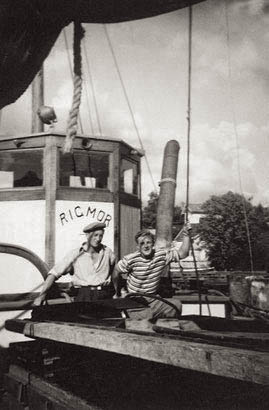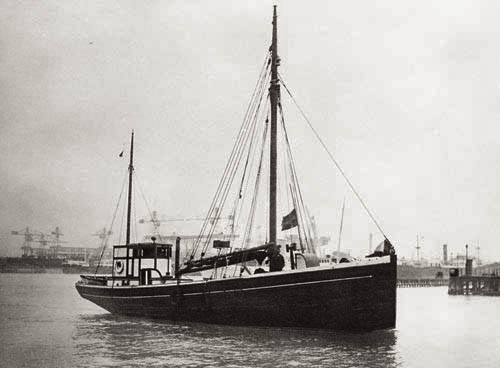
History ⪼ Sweden
Sweden 1937 - 1958
With the modernisation of the English fishing fleet followed the selling of the older vessels. Many trawlers were sold to Scandinavia. Between the years 1890 and 1937 over 250 English sailing trawlers were sold to Sweden alone.
On the 10th of April 1937 the contract was signed and John Harald Heimer became owner of DEODAR.
The broker was the commission agent of W. J. Head and the price was around 80 pounds. A great deal of the running rigging was missing so Mr Heimer needed to renew before departure for Sweden. By the end of April they were back home in Grundsund on the Swedish west coast.
The Heimer family purchased many sailng trawlers throughout the years. These found new owners in Sweden and were used for fishing or cargo. DEODAR was registered and measured according to Swedish requirements and certified as a Swedish owned vessel with the Reg. No 8180.
The depression created difficulties in finding a new owner in Sweden. DEODAR was left idle, moored at Heimer´s place for a few years. In their efforts to find a new purchaser they had an engine installed, a one cylinder, 50 horse power, oil engine of the well known and popular brand AVANCE. The engine had been made already in 1927, bought second hand and put into DEODAR in 1939 at the "Lyckans slip" shipyard. Re-measured, she was then used as an auxiliary sailing vessel. In spite of this modernisation it took approximately five years for DEODAR to get back into commission after arriving in Sweden.
The Heimer family purchased many sailng trawlers throughout the years. These found new owners in Sweden and were used for fishing or cargo. DEODAR was registered and measured according to Swedish requirements and certified as a Swedish owned vessel with the Reg. No 8180.
The depression created difficulties in finding a new owner in Sweden. DEODAR was left idle, moored at Heimer´s place for a few years. In their efforts to find a new purchaser they had an engine installed, a one cylinder, 50 horse power, oil engine of the well known and popular brand AVANCE. The engine had been made already in 1927, bought second hand and put into DEODAR in 1939 at the "Lyckans slip" shipyard. Re-measured, she was then used as an auxiliary sailing vessel. In spite of this modernisation it took approximately five years for DEODAR to get back into commission after arriving in Sweden.
In december 1941 DEODAR was sold to Karl Albert Johansson and his son Sven Osvald. They were to choose between several different vessels. Some of which were EARLY BLOSSOM and GRATITUDE, but their choice was DEODAR. The new owners felt that the name DEODAR would however be difficult to pronounce so the decision was made to give her a new name. Different suggestions were made until they finally decided on RIGMOR.
During the spring of 1942 she was refitted as a cargo vessel. This involved the building of a cargo hold, a wheel house and the replacement of the tiller with a steering wheel. This work was carried out by Oskar Svenningsson at the Knippla Shipyard. In the midst of April times were busy. The sea on the Swedish west coast was now free of ice.
Loading capacity 95 tons was a little too limited to be economical but with a registered net tonnage under 40 registered tons at least one didn´t have to pay for pilotage.
Finally on April 18th 1942, all the new certificates became ready. RIGMOR was then classed as a trading vessel with her home port in Hamburgsund on the Swedish west coat.
During the spring of 1942 she was refitted as a cargo vessel. This involved the building of a cargo hold, a wheel house and the replacement of the tiller with a steering wheel. This work was carried out by Oskar Svenningsson at the Knippla Shipyard. In the midst of April times were busy. The sea on the Swedish west coast was now free of ice.
Loading capacity 95 tons was a little too limited to be economical but with a registered net tonnage under 40 registered tons at least one didn´t have to pay for pilotage.
Finally on April 18th 1942, all the new certificates became ready. RIGMOR was then classed as a trading vessel with her home port in Hamburgsund on the Swedish west coat.
From here on followed 17 very prosperous years for RIGMOR as a cargo ship. Sven married Inga in 1947 and had three children, Ann-Sofie, Sven-Erik and Roland.
The cargo varied. Mostly it was ice, which was loaded onboard in Friesfjorden near Oslo. The ice was sawn and loaded onboard in 100 kilo blocks. The freight was then shipped to some of the fishing harbours on the Swedish west coast, such as Hönö, Öckerö, Smögen och Åstol.
These freight trips continued day and night making the total trips per week at two. There was space onboard for 75 tons of ice and so the entire cargo was packed up to a height of one meter above the cargo hold and covered with tarpaulins making a very good load indeed, though she was not loaded to the maximum. The immense weight was evenly placed and the vessel took very well to sea. Despite the fact that there were no freezers onboard the ice did not manage to melt terribly much during the long trip to the fishing harbours, but it meant getting a move on as one was paid for the amount delivered and not for those kilos which did manage to melt under way.
There were other types of cargo towards the end of the 1940´s, namely Saltpeter in 50 kilo sacks which was then used to produce fertiliser. Soda was also freighted in 50 kilo sacks and nitric acid in glass jars placed on deck. These loads were taken in to Häröia in Fettriesfjorden and delivered to Landskrona, Helsinborg and Malmö, which were situated within the farming districts of the south west coast. As return freight, wheat was taken onboard and delivered to the Carnegie Brewery in Gothenburg.
Paving stones were also loaded onboard in the north western districts, Krokstrand, Pilegården, Boråsgården or Hälle and freighted to cities along the coast.
Rigmor remained in freight throughout the year 1958, which became the last season in occupation.
The cargo varied. Mostly it was ice, which was loaded onboard in Friesfjorden near Oslo. The ice was sawn and loaded onboard in 100 kilo blocks. The freight was then shipped to some of the fishing harbours on the Swedish west coast, such as Hönö, Öckerö, Smögen och Åstol.
These freight trips continued day and night making the total trips per week at two. There was space onboard for 75 tons of ice and so the entire cargo was packed up to a height of one meter above the cargo hold and covered with tarpaulins making a very good load indeed, though she was not loaded to the maximum. The immense weight was evenly placed and the vessel took very well to sea. Despite the fact that there were no freezers onboard the ice did not manage to melt terribly much during the long trip to the fishing harbours, but it meant getting a move on as one was paid for the amount delivered and not for those kilos which did manage to melt under way.
There were other types of cargo towards the end of the 1940´s, namely Saltpeter in 50 kilo sacks which was then used to produce fertiliser. Soda was also freighted in 50 kilo sacks and nitric acid in glass jars placed on deck. These loads were taken in to Häröia in Fettriesfjorden and delivered to Landskrona, Helsinborg and Malmö, which were situated within the farming districts of the south west coast. As return freight, wheat was taken onboard and delivered to the Carnegie Brewery in Gothenburg.
Paving stones were also loaded onboard in the north western districts, Krokstrand, Pilegården, Boråsgården or Hälle and freighted to cities along the coast.
Rigmor remained in freight throughout the year 1958, which became the last season in occupation.
Note: Photos in higher resolution coming soon!
Logo












